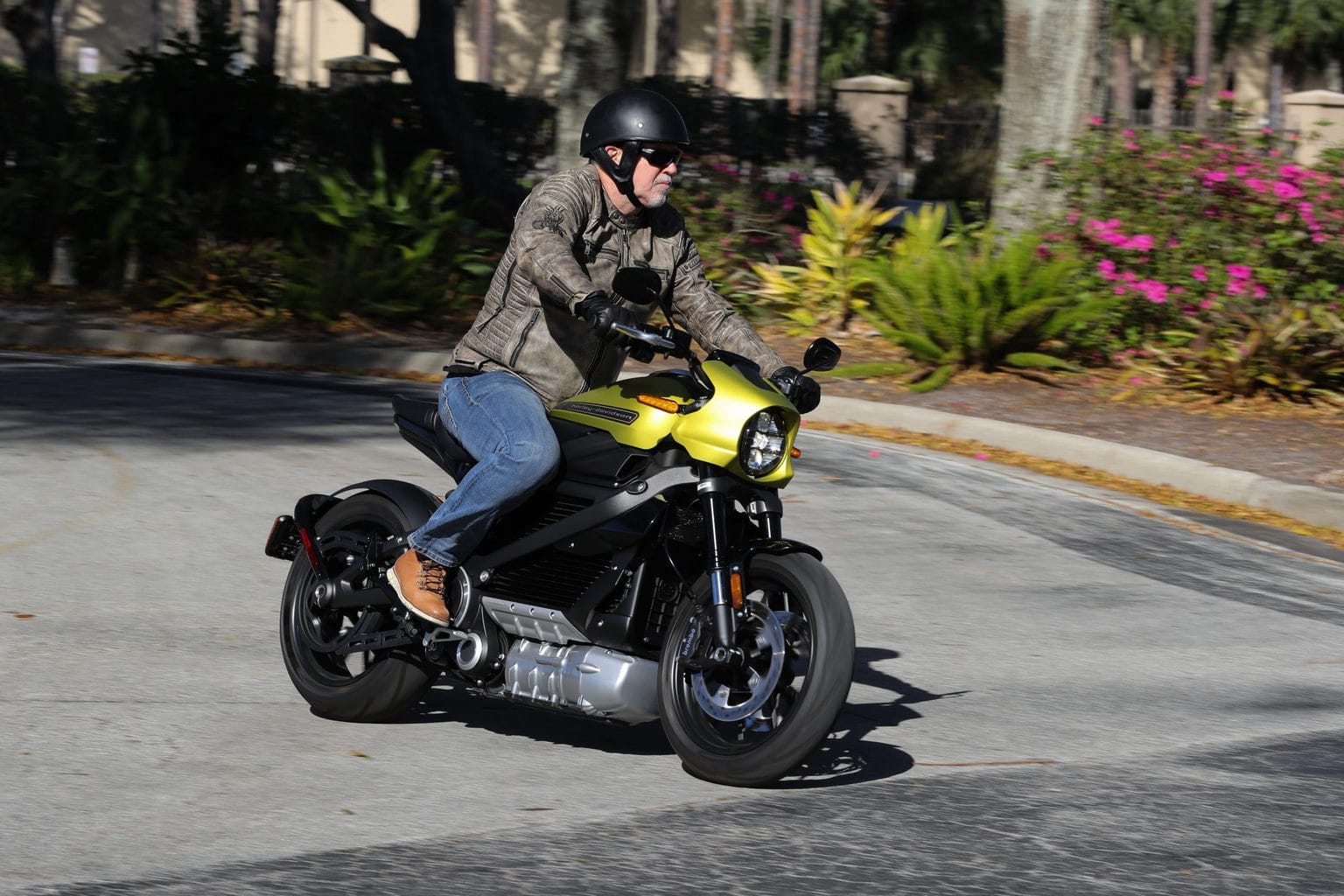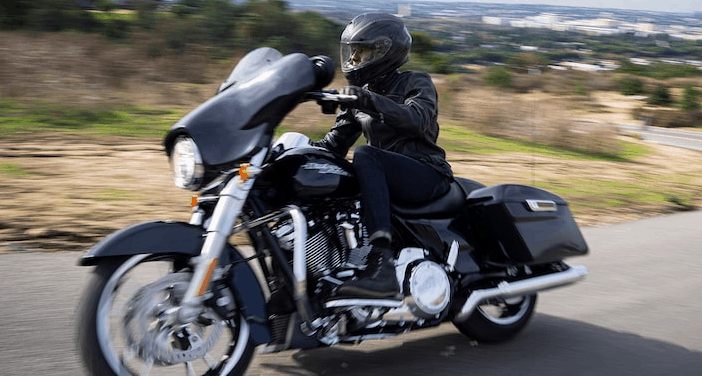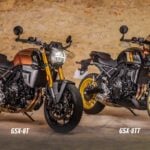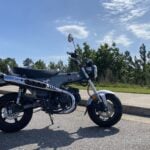How We Cognitively Equate Speed With Gas Powered Engines
I was 11 years old the first time I rode a motorized two wheeled vehicle. A buddy rolled up on his Tecumseh powered mini-bike. Nothing but an engine, seat, throttle, brake lever and a pipe welded to the down tubes for pegs- no clutch or tranny. He offered to let me ride the bike up the hill. Having seen bikers on dad’s RCA black & white, the first thing I did was twist the throttle to hear the engine, and suddenly the bike took off in my first “whiskey throttle” experience. I do recall the excited feeling of that engine growling and the smell of exhaust awakening my sleeping daredevil. Little did I know my brain was training itself to cognitively equate two wheeled motion (and speed) with several senses.
Fast forward 50 years to Daytona Bike Week and I found myself sitting on a 2020 Harley-Davidson LiveWire behind the H-D press tent with the head of Harley’s PR, Paul James. I’d come full circle now, sitting on a bike with pegs, a throttle and one brake lever on the bars- no clutch or tranny. The odd thing was, since there was no engine rumble nor exhaust initially my senses were confused. I believe herein lies one of the biggest obstacles for the EV manufacturers to overcome if they are to reach mass public appeal in the existing motorcycle riding communities- speed in and of itself isn’t enough to enjoy a motorcycle. Stick with me here.

After I had put in about 10 hours of total seat time straddled over large lithium ion batteries riding and reviewing the LiveWire in March, then after a weekend on the Zero SR/F in early April, I jumped on my V-Twin the day after the Zero ride and it finally hit me- there is so much more to motorcycle riding than just twisting the throttle. Yes, electric motorcycles attract the first time rider due to its ease of use (no clutch or tranny) and the eco-friendly aspect has its caché in the environmental crowd. But seasoned riders are having difficulty with the overall EV experience, and I think this is what’s causing the greatest pushback from much of the motorcycle riding public. This observation led me to explore how our senses process various aspects of motion on a motorcycle.
Touch + Sight + Sound + Smell = Speed
The human body goes through a cognitive process when it experiences speed, which is why almost every rider coming off a gas powered 5 or 6 speed bike sits on an electric motorcycle and almost immediately reaches for the clutch with their left hand and tries to check for neutral only to find a lack of both clutch and shift lever. A rider’s muscle memory kicks in and assumes the traditional rider position.
Processing speed is a cognitive ability that could be defined as the time it takes a person to conduct a mental task. It is related to the speed in which a person can understand and react to the information they receive, whether it be visual (letters and numbers), auditory (language), or movement (motion). In other words, processing speed is the time between receiving and responding to a stimulus. When operating a motorcycle with an internal combustion engine, clutch, transmission and throttle, the rider’s cognitive senses take in much information as we squeeze a clutch, roll the throttle, shift the gear lever and gently release the clutch to begin moving forward.
Riding a petrol-powered motorcycle requires a full body, four-limb interaction with the machine.
Over time, these synchronous motions become second nature as we almost become “one with the machine” feeling, seeing, hearing, smelling and sensing the tasks we command as it rolls forward faster and faster. Then we downshift to scrub off speed, getting more motor input into our cognitive brain as we use one or both brake levers to slow and stop. Going forward our body experiences drag from the wind, sound (and smell) from exhaust pipes and heat from the engine. The act of turning requires us to press down on the handlebar while leaning into the curve. Riding a petrol-powered motorcycle requires a full body, four-limb interaction with the machine, not terribly unlike flying a helicopter, one friend informed me.
Muscle Memory
All of these elements provide cognitive input from our extremities, developing an amazing sense of oneness as we shift our way up to speed and downshift to navigate turns and traffic. Over time the body begins to expect this massive, multi-tasked input to fully enjoy the act of riding a motorcycle. Even slowing at a stop sign and revving the engine as we decelerate, or while stopped, becomes a joyous cognitive expectation that the senses equate with what we call the “freedom of two wheels” between our legs and our “wind therapy.” Lest we forget the experiences of wheelies, burnouts, kneedrags (street), jumps, berms, whoops and hill climbs (dirt), all make up the thrill of motorbike riding.
*Editor note: Having cut my teeth on a Honda Elsinore 125 in the late 70’s I would mention here that to me, a two-stroke dirt bike just sounds faster than the current crop of four-strokers out there on the Supercross circuit.
Starting around 1915 (WWI), motorcycle production began introducing the US military and our allies to the modern version of the bikes we still ride today. This equates to over 100 years of human interaction with a throttle, clutch and gearbox. Sure, we’ve seen variations on this theme with suicide shifters, automatic transmissions and the like, but in the end, the human cognitive motor has been trained to experience the 4-part harmony of a motorcycle via a throttle, clutch, gear shifter and hand/foot brakes.
Shhhh!
There’s little wonder it’s taking some time and effort for electric motorcycles to catch on within existing rider communities. The human riding experience loses half the cognitive input to which it has become accustomed when riding an electric bike. You get a throttle and front/rear brake levers, either of which get limited use due to the regen braking feature of the electric motor. Electric bikes have no exhaust so we lose the sense of sound and smell, no engine rumble so we lose the familiar vibration feel and no clutch or tranny so the synchronous upshifting to top speed and down shifting in turns and traffic. I’ll never forget telling my wife that we were going out for the day to test the two Zero bikes. I shared that they were quiet and “you really can’t hear them”. Her response was “Is that safe?” She immediately equated the sound of my Harleys to people being able to hear me coming, thus being safer as in “Loud Pipes Save Lives”.
Riding tandem on electric bikes makes it a breeze to chat with your ride mates at stop lights- no sound, no clutch and no engine revving. In fact, the last thing you want to do on an electric bike is twist the throttle while parked. One of the first things many bikers do after starting an Internal Combustion Engine (ICE) bike is blip the throttle and rev the engine. This is obviously a non sequitur on an EV. The good news is – Harley, Zero and other manufacturers knew this would happen so at Bike Week Harley had a few dyno stations set up to experience the LiveWire prior to getting on the road. In fact, EV manufacturers realized that humans had been trained to use all of these senses on motorcycles and had to design EV bike software to override throttle actuation while the bike was resting on its kickstand. The engineers had much to consider for safety so in another instance, and due to the torque of these electric engines, engineers incorporated a gyro sensor (think iPhone actuation but way bigger) in the bike that would kick in and prevent the bike from riding on it’s rear tire as well. If you’ve ever ridden a current EV bike you know that they are torque monsters and without these safety features, the rider could end up on his birthday seat pronto!
Pour or Plug?
There’s no question we could explore this topic in greater length and perhaps we will extend this exploration into a part 2 in the near future, but to put a bow on this one, I guess we should summarize what we’ve discovered through our limited exposure to the two wildly different propulsion systems currently on offer in the motorcycle markets. There is no question the Internal Combustion Engine powered bikes were here first and have a majority of the mind share of the riding public. The fuel required on an “ICE” bike has an existing and vast infrastructure of fuel stations and long distance travel isn’t a concern. When the term “motorcycle” comes up in conversation, a human’s initial thought is typically one of sound and speed. Perhaps we go back to a friend or relative who had a bike and we recall the smell, sound and sight of her or him riding up, throttle revving, stopping and stepping on the gear lever searching for the coveted “N”.
When the term “Electric Motorcycle” hits our lexicon, veteran riders seem to instantly think space age, next generation “Jetson’s whine” from the engine and exclaim, “Not me!” Many current riders think of EV’s as a bit of novelty- and that’s fine, you don’t have to like it. The range issue will eventually get addressed through the coming infrastructure of charging stations and in 5-10 years, electric bikes will be very “normal”. I think as riders we need to understand that the next generation (of riders) embraces technology and assimilates cognitive experiences differently than the current riding gens. After all, I never thought I would see the day we didn’t need a “home phone” nor the fact that our grandchildren don’t understand what “Hang up the phone” means. We live in an age where new riders never drove a car with a clutch and the idea of shifting is foreign to them and this is where the EV market will eventually shine. After all, who wouldn’t want to get on a bike with a throttle, one brake lever and two pegs? I did at age 11. Enjoy the “Ride Life”!
Just my thoughts. I’d love to hear yours! Hit us up in the comments below.
Phil


































I totally agree… I also ‘started’ with 2-stroke dirt bikes, and even 2-stroke street bikes… and “The Sound” is totally different… and is a part of that subconscious ‘feeling’ of vehicle performance. You can “Hear Speed” as the RPMs increase… or the visceral experience as a NASCAR Racer “Roars Past”… and you “Hear the potential power” of a powerful V8 engine, as it ‘rumbles’ in the parking lot… Knowing it is Fast because you can feel the vibrations as those big pistons go up and down… just waiting to Show You the torque they are ready to unleash… Now, those big pistons are being replaced with turbochargers, that squeal rather than rumble, or no sound at all as the electric motor simply creates a powerful magnetic field that silently rotates as fast or slow as a rheostat tells it to…
Well Said Floyd. The NASCAR Analogy totally fits here. I recall “Feeling” Power at the Drag Races as well.
In 2016 I purchased a new Indian Scout. With factory silencers it was very quiet. I can’t tell you how many times I had to avoid cars pulling into my lane / me while riding to and from work. The day I put new mufflers on the bike, those events stopped. Loud pipes do save lives. I can’t imagine riding an all but silent motorcycle. This may become less of an issue as more new vehicles come standard with lane departure, proximity alarms and other safety features.
IMO electric motors are soulless. I like engines, they live and breathe and are a huge part of the experience of riding on two wheels. I have no interest in ever riding or owning one.
I had never really thought about how my experiences of speed were tied to other sensations, i.e. noise (pipes), vibration, shifting, braking, throttling, etc. And then I rode an electric with none of that, except the whine of the electric driven motor, and of course, the wind. I’d been hardwired to experience speed in the context of those other sensations, which made riding an electric a wholly new experience at first.
Good discussion, Phil.